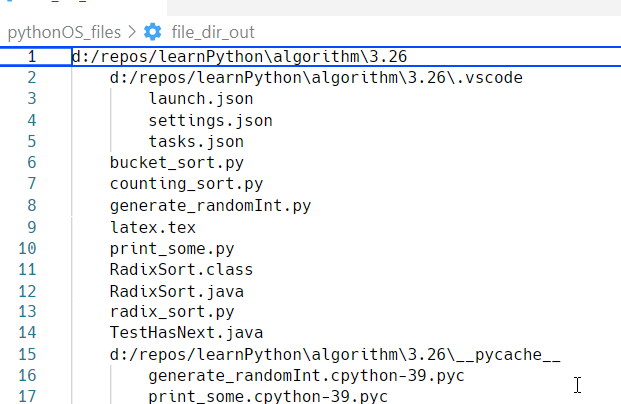code
"""
设定一个递归函数travers_dir(dirName,depthStop,...);
该函数支持指定递归的深度;
同时要求能够体现目录间的层次(通过制表符缩进来表达 🅱 )
具体规则如下:当指定深度depth_stop<=0时,尽可能的递归当前目录下的子目录(否则递归的深度就是depth_stop,或者不超过depth_stop);
默认尽可能递归.
该函数接收一个目录字符串参数,函数进入改目录打印出所有文件名以及目录名此外,如果被打印的对象时目录时,需要以该目录为参数在调用一次traverse_dir
在以下实现中,您不应当传入第三个参数,如果为了安全起见,您可以为其在做一次浅封装,使得函数只有两个参数,而函数内部则调用traverse_dir()
"""
import os
import os.path as op
""" 本函数主要用到:os.listdir()以及os.path.isdir()以及一些判断技巧和debug过程中的控制技巧,去掉日志语句后,代码量较少 """
dirPrefix = "d:/repos/learnPython"
dirPost = "algorithm"
dirName = op.join(dirPrefix, dirPost)
pathOut = "file_dir_out"
def empyt(obj):
...
d = print
d = empyt
if op.exists(pathOut):
os.remove(pathOut)
def append(content, fileName=pathOut):
with open(fileName, 'a') as fout:
fout.write(content+"\n")
out = append
depth = 0
def traverse_dir(dirName, stop_depth=0, depth=0):
if stop_depth > 0:
if stop_depth > depth:
pass
else:
return
d("\t new invoke of traverse_dir()")
items = os.listdir(dirName)
d(items)
if (items):
for item in items:
newPath = op.join(dirName, item)
d(newPath)
if op.isdir(newPath):
d("dirName:"+item+"\twill be enter by new invoke of traverse_dir")
dirStr = depth*"\t"+newPath
print(dirStr)
out(dirStr)
traverse_dir(newPath, stop_depth, depth+1)
else:
print(item)
out(depth*"\t"+item)
if __name__ == "__main__":
traverse_dir(dirName, 0)
效果预览

|
